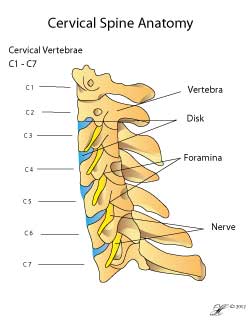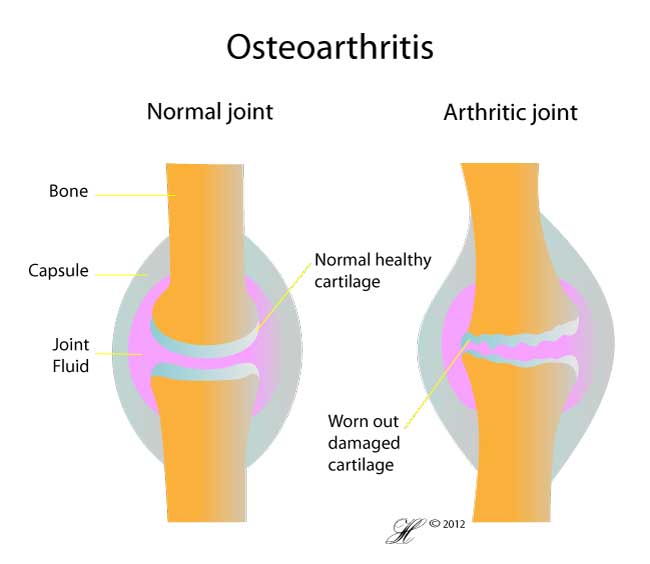
Diagram of the Cervical Spine (neck) showing normal anatomy
Cervical spondylosis is defined as arthritis of the neck.
The bones in the neck (or “cervical spine”) are affected by ageing and the inevitable deterioration of arthritis in the joints.
Over time, arthritis of the neck (cervical spondylosis) may result from bony spurs and problems with ligaments and disks.
The spinal canal may narrow (stenosis) and compress the spinal cord and nerves to the arms. Injuries can also cause spinal cord compression.
The pain that results may range from mild discomfort to severe, crippling dysfunction.
Symptoms
Cervical spondylosis can lead to chronic pain and stiffness in the neck that may also radiate to the upper extremities (radiculopathy).
- Neck pain and stiffness may be worse with upright activity.
- You may have numbness and weakness in the arms, hands and fingers, and trouble walking due to weakness in the legs.
- You may feel or hear grinding or popping in the neck when you move.
- Muscle spasms or headaches may originate in the neck.
The condition can make you feel irritable and fatigued, disturb your sleep and impair your ability to work. See your doctor soon for diagnosis and treatment.
Causes
Disc degeneration and bony spurs
In the spine, arthritis can result as the disc between the blocks of bone (vertebrae) forming our spine degenerates and loses water content. In children and young adults, discs have high water content. As we get older, our discs begin to dry out and weaken. This problem causes settling, or collapse, of the disk spaces and loss of disc space height.
As the facet joints experience increased pressure, they also begin to degenerate and develop arthritis, similar to the hip or knee joint. The cartilage that covers and protects the joints wears away.
If the cartilage wears away completely, it can result in bone rubbing on bone. To make up for the lost cartilage, your body may respond by growing new bone in your facet joints to help support the vertebrae. Over time, this bone overgrowth — called spurs — may narrow the space for the nerves to pass through (stenosis).

Risk Factors
- Ageing and wear and tear on the spine.
- Frequent sports and activities that place stress on or continually overstretch/hyperextend the spine.
- Congenital – may develop at birth, specifically in those with thin vertebrae.
Investigations
Give the doctor your complete medical history. This can help him or her rule out other conditions that cause symptoms similar to cervical spondylosis. The doctor will examine you physically and may take X-rays or use other diagnostic imaging tests to see inside the body.
Medical history. Tell the doctor if you have any illnesses or chronic conditions. Describe the exact location of neck pain and when the problem began. What does the pain feel like? Have you ever injured your neck or been previously treated for neck pain?
Physical exam. The doctor may identify tender spots along the back of your neck and evaluate your ability to move the neck in various directions. He or she may test your reflexes and the function of nerves and muscles in the arms and legs. The doctor may want to watch you walk.
Imaging. X-rays and/or MRI (Magnetic Resonance Imaging) studies may show bone spurs and other abnormalities and reveal the extent of damage to the cervical spine.
In certain cases, you may need additional blood tests before the doctor can make a diagnosis. Sometimes the doctor may want you to see other medical specialists for evaluation.
Complications
Cervical spondylosis is the most common cause of spinal cord dysfunction in older adults.
In a small percentage of cases, cervical spondylosis may compress one or more of the spinal nerves — a condition called cervical radiculopathy. Bone spurs and other irregularities caused by cervical spondylosis also may reduce the diameter of the canal that houses the spinal cord. When the spinal canal narrows to the point that it causes spinal cord injury, the resulting condition is referred to as cervical myelopathy. Both cervical radiculopathy and cervical myelopathy can lead to permanent disability.
Treatment
If you have cervical spondylosis, symptoms may last for several months or become chronic. Most of the time if symptoms are mild, the doctor may recommend a variety of non-surgical treatments. Rest, medication and physical therapy may take away most of your symptoms, but do not treat the underlying cause. The doctor may want to see you again to check if symptoms have gotten better, worse or stayed the same.
Rest. You may need to wear a soft cervical collar or neck brace to limit neck motion and relieve nerve irritation.
Medication. The doctor may prescribe non-steroidal anti-inflammatory medications (NSAIDs) or other non-narcotic pain relievers to relieve pain and reduce swelling.
Physical therapy. A cervical traction device, hot and cold therapy or active exercise program may help relieve symptoms. Exercises may include neck strengthening, neck and shoulder stretching and aerobic exercises. Gentle massage and improving your posture may also help.
Surgery. Surgery may be necessary if you have severe pain that does not improve with other treatments or progressive neurological symptoms. Surgery may remove bone spurs or disk material (decompression) and provide lasting relief.
Seeking Advice
Your Family Doctor (GP)
Your Family Doctor will be able to diagnose and help treat your problem. He or she will be able to
- tell you about your problem
- advise you of the best treatment methods
- prescribe you medications
- and if necessary, refer you to Specialists (Consultants) for further treatment
Prevention
Prevention of spondylosis means to prevent from exacerbation of symptoms and can be done by some posture recommendation and neck exercise.
Neck posture in cervical spondylosis
A hard bed is recommended with a thin pillow. Lying straight without a pillow is preferred but a thin pillow should be used when lying on the side to avoid having your neck hanging down.
Neck exercise in cervical spondylosis
Neck exercise helps in improving neck posture. Turn your neck to one side against the push of your hand and do the same for the other side. Stretch your neck upwards and downwards too. This exercise will help in maintaining the health of the back bones to avoid any nerve root compression.
F.A.Q. | Frequently Asked Questions
How does a person’s life style cause cervical spondylosis?
Activities like reading and writing for prolonged period demand a continuous muscle and ligaments tension and can result in neck strain. Some of the activities that causes gradual strain of the structures of the neck leading to neck pain and stiffness include:
- Habit of holding the telephone on one shoulder and leaning at it for long time.
- Sitting or standing still for long periods.
- Driving continuously for long hours.
- Sleeping in awkward positions with many pillows below the neck and shoulders.
To avoid neck strain that can lead to problems one is advised to take small breaks and to do muscle strengthening exercise.
